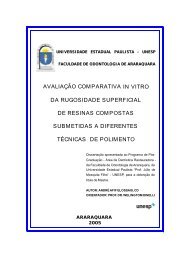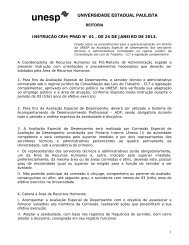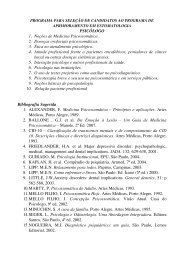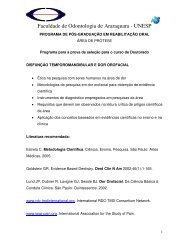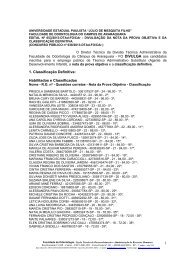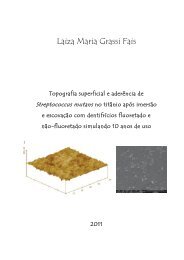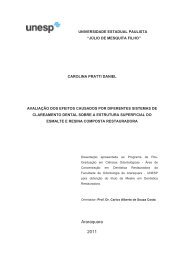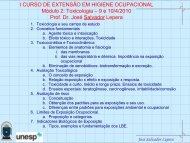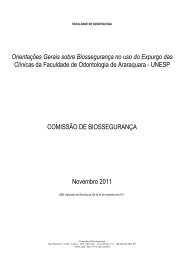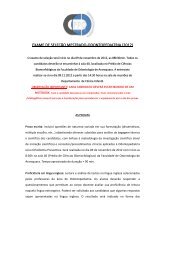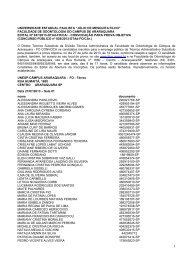Ana Paula Dias Ribeiro - Faculdade de Odontologia - Unesp
Ana Paula Dias Ribeiro - Faculdade de Odontologia - Unesp
Ana Paula Dias Ribeiro - Faculdade de Odontologia - Unesp
- No tags were found...
Create successful ePaper yourself
Turn your PDF publications into a flip-book with our unique Google optimized e-Paper software.
infection, parotitis and staphylococcal mucositis [2]. There is also scientific evi<strong>de</strong>ncethat the oral cavity can be the source of the staphylococci responsible for infection atdistant sites, such as aspiration pneumonia, endocarditis, acute septic arthritis andchronic lung diseases [3].As the oral cavity can be an important reservoir of this opportunistic pathogen,much effort has been ma<strong>de</strong> in or<strong>de</strong>r to promote the <strong>de</strong>colonization of Staphylococcuscarriers [4]. However, the strategies to eliminate the S. aureus strains have beenchallenged with the <strong>de</strong>velopment of antibiotic-resistant microorganisms, such as themethicillin-resistant S. aureus (MRSA). Strains of MRSA were first <strong>de</strong>tected in 1961and these pathogens are currently prevalent worldwi<strong>de</strong> [5]. MRSA has become amajor problem in nososcomial infections as it is responsible for significantly highermorbidity and mortality and increased healthcare costs [6]. It is known that thecolonization prece<strong>de</strong>s the systemic infection and therefore <strong>de</strong>colonization may reducethe risk of MRSA infection in individual carriers and prevent cross-infection to otherpatients or healthcare workers. Intranasal mupirocin, daily chlorhexidine body wash,antibiotics such as rifampin and doxycline, oral hygiene procedures, use of <strong>de</strong>nturecleansingagents and <strong>de</strong>nture sterilization methods have been proposed to preventcolonization by MRSA and methicillin-susceptible S. aureus (MSSA) [6,7]. However,a systematic review conclu<strong>de</strong>d that there is insufficient evi<strong>de</strong>nce to support the use ofany topical or systemic antimicrobial therapy for eradicating MRSA [8].The photodynamic therapy (PDT) has emerged in the clinical field as apotential alternative to antibiotics for inactivating resistant microorganisms using anon-toxic light-sensitive compound (known as photosensitizer - PS), visible light andoxygen. Briefly, activation of the PS by a visible light that matches its photophysicalproperties generates reactive oxygen species (ROS) like free radicals by electron orhydrogen transfer (type I reaction) or reactive singlet oxygen by direct energy transferto oxygen (type II reaction) [9]. Photodynamic inactivation of microorganisms hasadvantages, such as the local application of PS and light, which limits the action ofROS and avoids systemic effects on normal bacterial flora [10]. In addition, unlikeantibiotics, which have a single target in the microbial cell, the reactive speciesgenerated by the photodynamic reaction have a multifunctional nature and candamage multiple cellular structures, reducing the chances of <strong>de</strong>velopment of PDTresistantstrains [11]. Dovigo et al. [12] observed that fluconazole-resistant C. albicansand C. glabrata strains were sensitivity to PDT, although they were less susceptible



